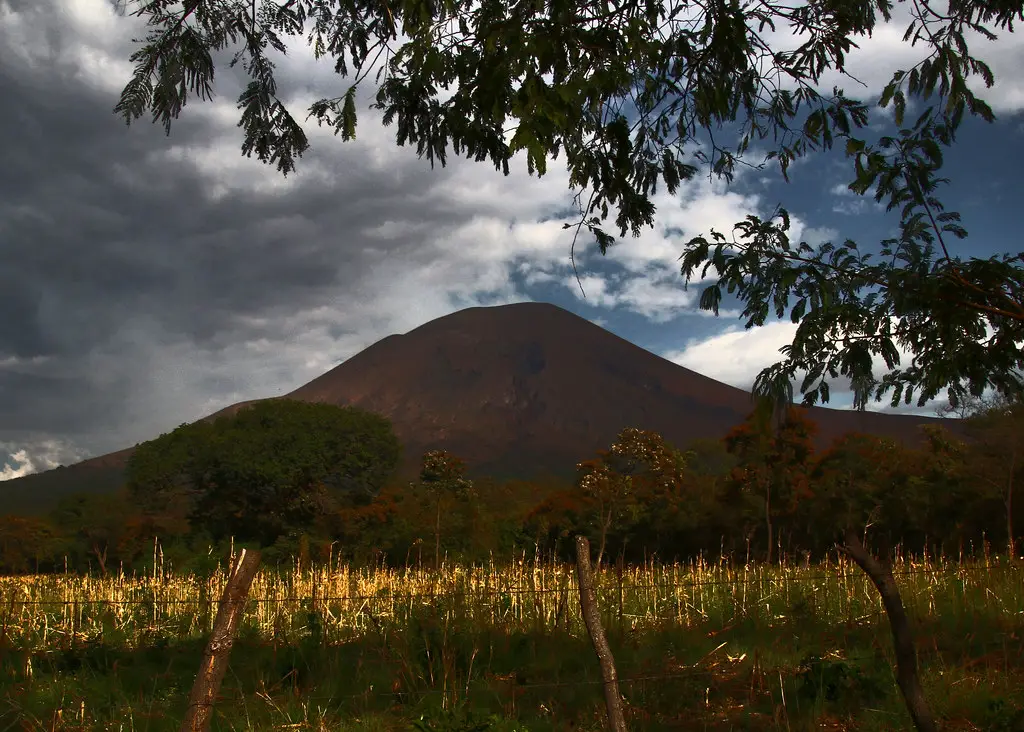The Telica Volcano, also known as the Volcán Telica, is one of the most active volcanoes in Nicaragua. Located approximately 12 miles northeast of León, it consists of a 3,481-foot summit that includes several interlocking cones with a main double crater that is 2,296-feet-wide.
According to the Global Volcanism Program at the Smithsonian’s Museum of Natural History, the Telica is an eroded stratovolcano within the volcano group of the same name in a general northwestern alignment. Its first major documented eruption dates back to 1529 with its last major explosion sending ash into the area in 1999. It continues to show signs of volcanic activity including seismic activity and steaming fumaroles with its latest activity recorded in July 2008.
Today, glowing magma can be seen at the bottom of its northeastern crater, which has a depth of 393 feet. Its proximity to the city of León makes the volcano a popular tourist attraction. Although the hike is less difficult than the nearby San Cristóbal Volcano, it is still moderately difficult due to the high temperatures, lack of water and long, slow ascent. But the dry, tropical landscapes provide amazing scenery and the summit offers breathtaking views of the nearby volcanic chain.
Exploring the Telica Volcano in Nicaragua
As one of Nicaragua’s numerous active volcanoes, the primary attraction for adventure travelers is to explore and complete the challenging climb to its summit for views of its glowing magma and venting fumaroles. Unlike other volcanoes that provide paved roads such as the Mombacho and Masaya, there is no road access to the foot of the volcano. According to ViaNica, the slopes are not as steep either, but the difficulty of the climb is mostly the entire length of the trail itself. The complete hike takes between seven to 12 hours (depending on ability level) and tour companies offer the option to stay overnight near the crater. This also provides an excellent chance to view the glowing magma at night.
There are two main ways to approach the volcano: 1- From Telica, on a road to a community called La Quimera; and 2- From San Jacinto, which is known for its bubbling mud pots. The route from San Jacinto is the most popular but since there are no roads up the volcano, ViaNica states, “You have no other choice than to spend most of your time hiking TO instead of ON the volcano.” For most climbers, the hike to the volcano takes between three to four hours, while the hike to the summit takes one to two hours.
But the reward comes at the crater rim, which provides spectacular views of the surroundings as well as a glimpse into nature’s power. Depending on the wind direction and the smoke, visitors have a chance to look into the crater with its vertical walls and watch the lava boiling and the fumaroles steaming. It is one of the few volcanoes in Central America where a climber can safely view glowing magma.
Exploring the Mud Pots of San Jacinto, Nicaragua
The Mud Pots, also known as the Hervideros, are located behind the town of San Jacinto (northeast of León). The alignment of the steaming fumaroles and mud pots suggest a connection between the location and the Telica volcanic range. As stated by the Global Volcanism Program, magmatic steam and gases have been emitted from the thermal area at a fairly consistent rate for many years.
A convenient day trip from León, the mud pots are safe and unique views of volcanic activity. The field is relatively small but it includes views of a variety of holes that differ in both size and color. It is an additional benefit to beginning the trek to the Telica Volcano from San Jacinto and it is easy to understand why it is a popular tourist destination.
Although the Telica Volcano is more accessible than its counterpart, the San Cristóbal Volcano, it still provides adventure tourists with a moderately difficult climb. But it is one of the few volcanoes where climbers can peer into the active crater with relatively safe consequences. It is a must-see destination along with the other active volcanoes in the country that include: Cerro Negro, Masaya, and the Concepción.

It’s not a matter of where, but when. Time is precious and my time spent living and experience the cultures of this world is what I lust for. This is why I created this website, to share true, genuine experiences and not just typical touristy info. Travel, the love of coffee, and food!
